Definitions
This page is work in progress.
In the overall field of the ICT sector we often lack a clear terminology. We refer to large, vertically-integrated digital product companies as ‘BigTech’, implying they are ‘big technology’ companies, which is already confusing – do they make all kinds of technology or only digital technologies? And aren’t they big Information Technology (IT) companies? And what’s the difference between Digital Technology (DT) and Information Technology (IT)?
Table of contents
- Digital vs. IT
- Software
- Software Disciplines
- Digital Product
- Sustainability
- Green IT
- Sustainable IT
- Green Software
- Sustainable Software
Digital vs. IT
A simple definition: Anything described as ‘digital’ refers to products, technologies (both software and hardware) or companies which exist in the internet marketplace only (‘digital realm’). If you’d turn off the internet, they would not exist anymore.
Information Technology (IT) is a very ambiguous term. It refers to either the equipment (servers, network switches) or software. In the context of software, it has an implied definition of software which helps a non-digital organization run its operations. If you’d turn off the internet, a company would still function, albeit slower or limited (think about a super market).
In that context, the phrase “digital transformation” is often used to refer to the process of turning those IT-supported traditional businesses to internet-dependent, digital businesses.
Software
What both IT-enabled organizations and digital businesses have in common, is that both eventually use or produce software. Some examples:
- A digital product company may use an open-source AI model (software) and an open-source website builder (software) to launch its product.
- An enterprise company may use an Enterprise Resource Planning system (software) to optimize its processes.
- An enterprise company may build its own package tracking system (software) on-top of an existing enterprise platform such an Oracle database (software).
- A digital technology company may build its own thermostat (hardware) with custom-made firmware (software), using an existing open-source database (software) to store the data from the devices.
- A consultancy company may take an open-source product (software, e.g. Nextcloud, Linux, Kubernetes) and wrap commercial services around it (installation, support, …)
All of these use software to attain a certain outcome - be it to improve a business’s efficiency, deliver a digital product to the internet marketplace or to sell services.
Software Disciplines
The process of producing & delivering software can be divided into different phases.
The phases are roughly based on the Life Cycle Assessment framework for assessing environmental & social impacts across the life cycle of a product. We deliberately skip the “Raw Material Extraction” step as physically software does not exist in the physical world (more on that here (link needed).
| Discipline/Phase | Existing Practices |
|---|---|
| Design | Requirements engineering, business analysis, specification, user stories, use cases, functional & non-functional requirements, software design, architecture, product management, user interface design, user experience design, web design, among others. |
| Production | Software development, software engineering, coding, development, agile development, programming, software testing, web development, among others. |
| Delivery | DevOps, software delivery, platform engineering, CloudOps, cloud engineering, continuous integration, continuous delivery, deployment, artifacts, release management, build automation, amongst others. |
| Usage | Ops, operations, site reliability engineering, system administration, incident management, IT operations, IT infrastructure management, disaster recovery, monitoring & alerting, load balancing, capacity planning, production support, amongst others. |
| Disposal | Software decommissioning, archiving, migration, legacy system migration, software asset management, amongst others. |
In the context of this Wiki we refer to these phases instead of specifying a practice directly for the sake of making the content more widely applicable and easier to understand.
Digital Product
To describe our digital ecosystem in a simple way, Leitmotiv created a taxonomy, which you can see below.
Every layer in this taxonomy contains software. As an example, Kubernetes, OpenStack or VMWare are all virtualization & orchestration platforms which help digital infrastructure to produce & allocate digital resources. This Wiki is not aimed at the software within layers of digital infrastructure & supporting technologies but at the digital products themselves.
In this wiki, we focus on digital products, which we define as a software-based product that:
- Must have a business model
- Could be assembled of open-source or properietary technology
- Must consume digital resources (compute, memory, storage, network)
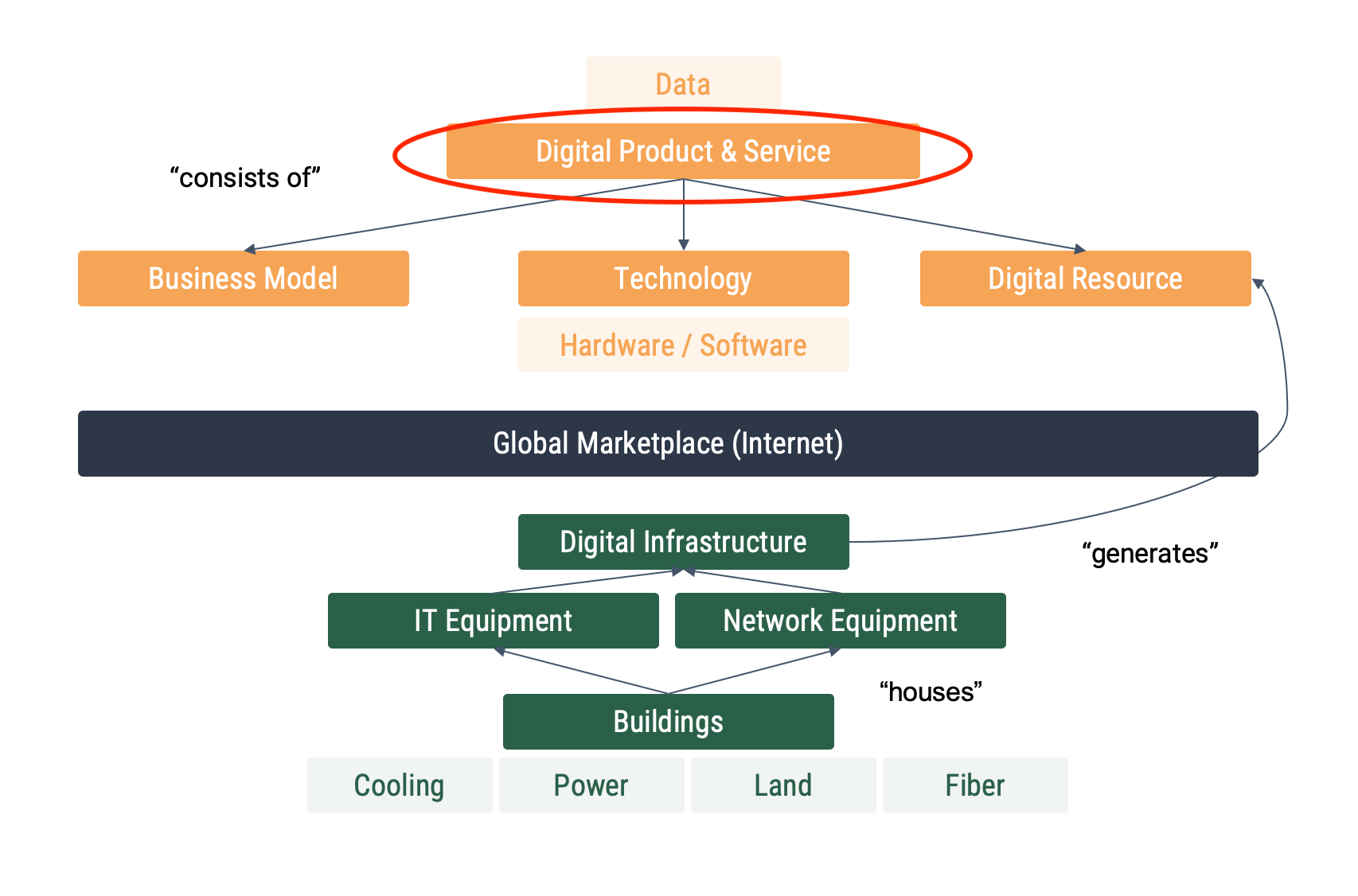
Here are a few examples:
- Online-Banking for a bank: If a bank provides online-banking as a feature to its banking offering, the online-banking software is a digital product (business model is ‘bundled’ with a bank account, likely it will use open-source/proprietary technology to provide the online banking experience and it consumes digital resources both server-side and client-side).
- Digital media platform: A digital media platform, such as Snapchat or the New York Times is a digital product. Business model may be subscription or advertising, the underlying technology maybe open-source (Wordpress, Redis database) or proprietary. Both consume digital resources client- and server-side.
- Digital marketplace: A digital marketplace, such as Booking.com or Airbnb, is a digital product. The business model is a marketplace with commission. The underlying technology maybe open-source or proprietary. Both consume digital resources client- and server-side.
- Desktop application: A desktop application such as Adobe Photoshop is a digital product. Its business model is a subscription (used to be one-off license). The technology is likely open-source and proprietary. It consumes digital resources on the client-side (and server-side, e.g. for clou storage and sharing features).
Supply Chain
When we define digital products like this, we can think of everything below a digital product, as the supply chain. This supply chain may contain open-source technologies and digital resources (from cloud or hosting providers). Digital resources require digital infrastructure - data center buildings, IT hardware, networking equipment, fiber and so on.
Thinking about this as a supply chain, its easier to see the responsibility of digital product to drive sustainability down its supply chain.
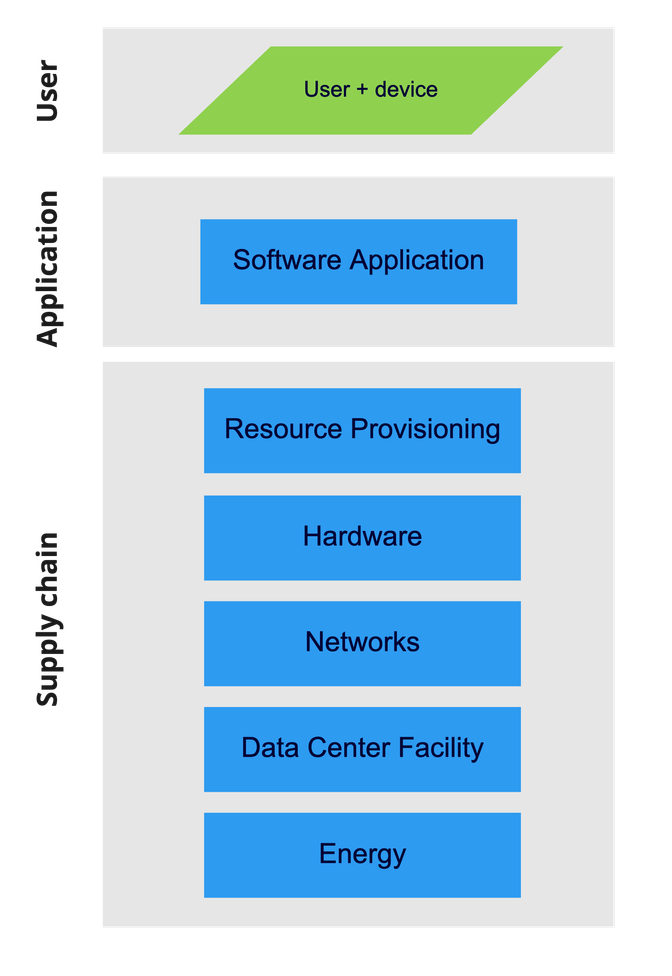
Digital products are software applications with supply chains.
This supply chain is what we call digital infrastructure. Digital infrastructure generates digital resources used to power the application and provide market access (connectivity), enabling customers to connect to an application.
The user can access an application using a device, e.g. a smartphone or computer with a browser.
The application requires digital resources to run. These resources are provisioned by digital infrastructure.
Digital infrastructure is the combination of IT hardware, networking and a data center facility.
The main input in the supply chain is electricity. As digital infrastructure generates heat, we use the term energy to capture both. The main output are digital resources.
Digital Resources
Sustainability
The 3 Pillars
In the context of this Wiki, we refer to Sustainability as the 3 pillars which need to be in balance to have a sustainable society: The needs of the environment, economics & society.
These have been expressed visually in various ways over the past. If you are interested in the history of ‘sustainability’, read this paper.
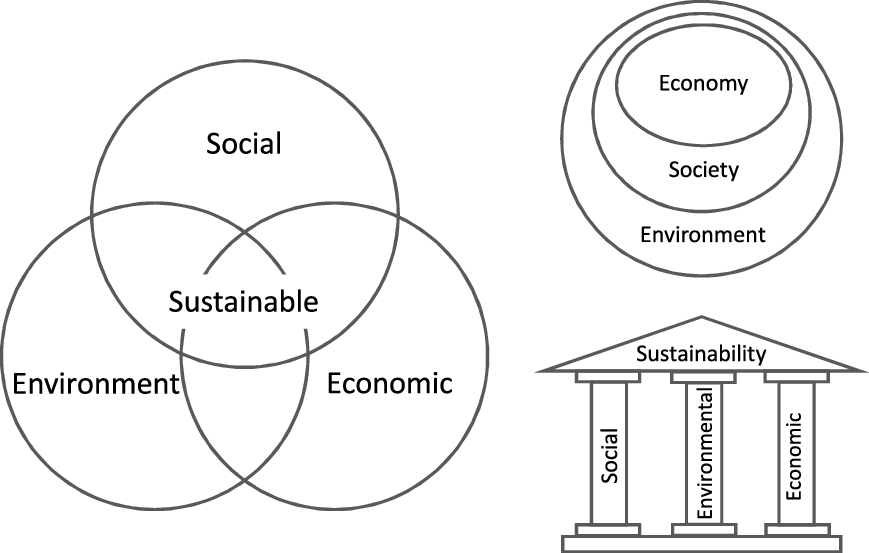
Source: (Purvis et al., 2019)
4 Sustainability Principles
Based on those pillars, four principles were developed that can be used to frame sustainability in more practical terms:
In a sustainable society, nature is not subject to systematically increasing…
- …concentrations of substances from the earth’s crust (such as fossil CO2, heavy metals and minerals)
- …concentrations of substances produced by society (such as antibiotics and endocrine disruptors)
- …degradation by physical means (such as deforestation and draining of groundwater tables).
- And in that society there are no structural obstacles to people’s health, influence, competence, impartiality and meaning.
Sustainable Development
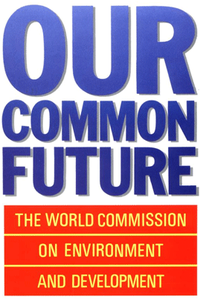
Even more important is the definition of sustainable development (development here meaning economic & societal development) or how we can progress as a global society without breaking us or our planet:
Sustainable development is a development that meets the needs of the present without compromising the ability of future generations to meet their own needs. It contains two key concepts within it: The concept of ‘needs’, in particular, the essential needs of the world’s poor, to which overriding priority should be given; and The idea of limitations imposed by the state of technology and social organization on the environment’s ability to meet present and future needs.
Planetary Boundaries
The last concept that is important to absorb and touch upon is the idea of planetary boundaries. This is a method that helps us appreciate the natural limitations of our world.
The planetary boundaries concept presents a set of nine planetary boundaries within which humanity can continue to develop and thrive for generations to come. (Stockholm Resilience)
In September 2023, a team of scientists quantified, for the first time, all nine processes that regulate the stability and resilience of the Earth system.
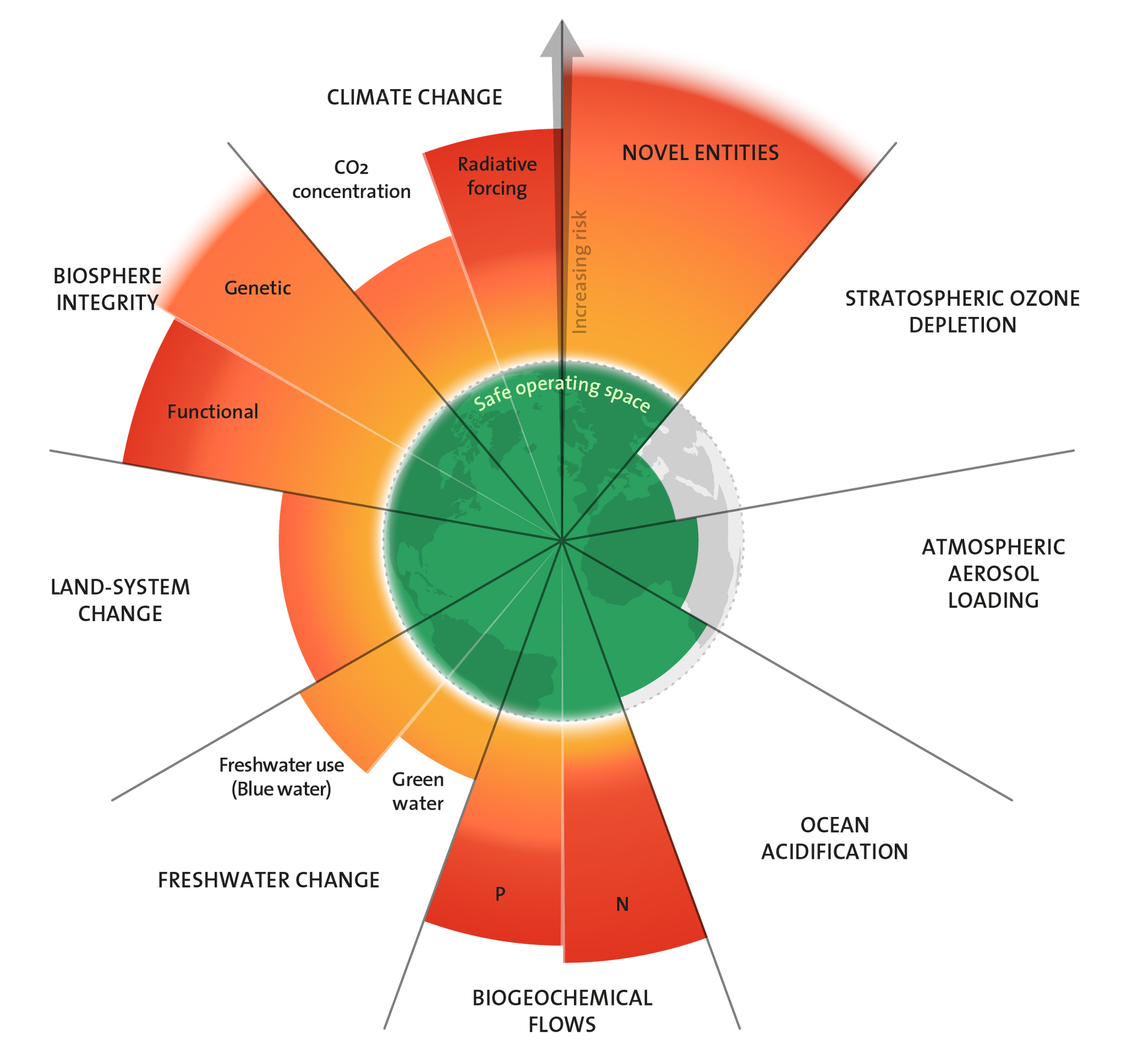
Source: Stockholm Resilience
Interpretation
In the context, we aim to organize, and provide knowledge in this wiki around high-level questions, related to this framing of sustainability. Read them here.
Green IT
The term “Green IT” first emerged in the early 2000s as a way to describe information technology products and services that have a lower environmental impact. According to Wikipedia it was the launch of Energy Star & TCO Certified, both voluntary labeling programs which are designed to promote and recognize the energy efficiency of ICT equipment, amongst other energy-intensive products, which began the movement.
As the term ‘green’ implies, the practice was focussed on reducing environmental impact in the wider sense, yet many efforts focused on energy efficiency. One example is a ranking of world’s greenest supercomputers, the Green 500. Here the emphasis is on the ratio of watts per flop or performance per unit of energy.
A noteworthy organization in Europe, which advocated for the adoption of Green IT practices, is GreenIT.fr, which still exits today. Further, the Green IT department of the German Environmental Agency has covered the topic with research publications since 20141.
The current movement of Sustainable IT, green, and sustainable software can be viewed as a rebirth of the movement, which lost momentum in the 2010s.
Sustainable IT
Green Software
Sustainable Software
Gröger, J., & Köhn, M. (2015). 07/2015 Nachhaltige Software-Dokumentation des Fachgesprächs „Nachhaltige Software“ am 28.11.2014. ↩
